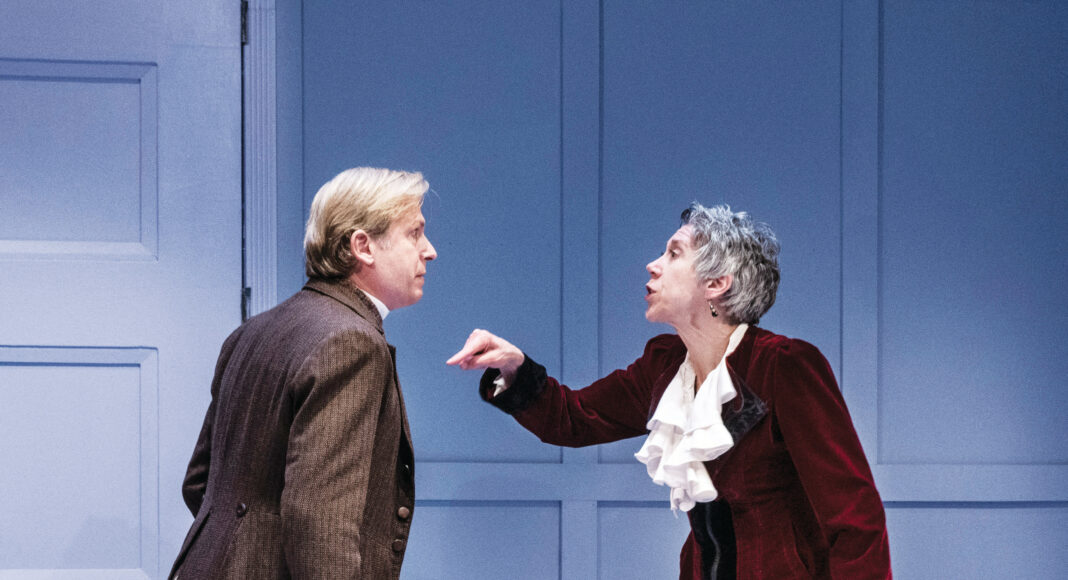The door that slammed shut so famously in Henrik Ibsen’s 1893 classic looms large in the Jewel Theatre’s A Doll’s House: Part 2, written in 2016 by Lucas Hnath. And while it won’t slam shut quite the same way this time, it will be opened—and closed—many times in an hour and a half. This taut, beautifully acted production treated opening night’s audience to elegant figures on a spare stage. Chartreuse velvet upholstery on the few pieces of furniture matches the crimson cut-velvet coat and dress worn by Nora Helmer (Julie James) and the handsomely tailored suit of her estranged husband Torvald (David Arrow). Everything sets the stage for a witty and searching exploration of whether a man and a woman can understand each other. Kudos to scenic designer Andrea Bechart.
In addition to the famous couple, the Helmer’s long-suffering housekeeper Anne Marie (a crisp Nancy Carlin) and daughter Emmy (ably played by Sara Safari) round out the quartet of players. A suite of passionate arguments and bold confessions ensues until the startling and richly satisfying conclusion.
During her 15-year absence, Nora has successfully—maybe—bucked the trappings of a proper marriage and the late 19th-century status quo in which she was raised. Since then, she’s lived as a single free spirit, indulged her desires, written feminist manifestos and become a successful modern woman. All achievements are destined to shake bourgeois values. Like Ibsen, playwright Hnath examines those rigid values through bristling stand-offs among all four characters while probing deeper into the negotiations required of marriage.
Nora returns to her husband’s house, wrapped in the trappings of success, with one final demand—a divorce. She needs that legal piece of paper so she can, in good faith, practice the authentic single life that she has preached in her best-selling books. While on her own, Nora has struggled to extract herself from cultural convention, to “hear her own voice.” She returns as the play opens, triumphantly proclaiming that people do change—that she has changed. The beauty of being human, however, is that we don’t ever quite get it, at least not all of it. Each of us gropes and thrashes and tries to see beyond the moment. As the play deepens its focus, it questions whether understanding—the habits that bind, define and harden between people—is even possible.
Although the setting remains Ibsen’s 19th century, the play’s language is our own contemporary vernacular, a conceit that often works exceptionally well to keep us surprised, amused and engaged. Often, but not always. Perhaps because we are in Santa Cruz, this six-year-old play feels curiously dated. Many of the feminist epiphanies proclaimed by Nora have been in circulation for decades. Yet we would do well to examine them again. Much of the back-and-forth dialogue explores post-Ibsen implications of feeling trapped, wanting more, existing within a prison of social conventions. The “what if?” question each character asks produces a few bracing responses. And many predictable ones.
Was it braver of Nora to leave and start a new life—if such a thing is even possible—or would it be braver to stay and work through the difficulties of a marriage? Daughter Emmy has a few sharp retorts, and they are not the compliant “so glad you’re home, mommy” speeches our returning free spirit had expected. Once Torvald enters the stage, everything pulses with strange new momentum. Given lines that Ibsen didn’t dare, Arrow’s charismatic performance illuminates Torvald’s 15 years of abandonment.
James, in an extravagantly mercurial performance, gives juice and rage to her every line, and Arrow is every bit her match. The air becomes electric when he finally has his say about the past and how things are now. Both these resourceful actors force us to consider unanswerable questions: How is it possible to be an authentic human being and to be true to oneself while living with another person? Big stuff.
I could not help but sense that opening night’s audience—perhaps wearied by three years of Covid, inflation, soul-eroding political chaos, so many oppressive unknowns—was anticipating something more upbeat, more frothily entertaining. But innovative theater must be in the business of pushing us out of our comfort zones. Could audiences rise to the occasion? The actors in A Doll’s House: Part 2 certainly did.















Wonderfully enticing and balanced review. Reviews without revealing too much, allowing the reader to anticipate a thought provoking night at the theater. I look forward to seeing the play. Thanks Christina!